State and Local government attorneys are frequently tasked with handling unique and niche issues, and often need to work on short time frames and with limited budgets. Many are turning to the Lexis+™ legal research service to slim down research and strategy preparation for their civil and criminal caseload—leveraging an efficient workflow by combining previously discrete or unavailable tools on one platform.
In 2021, LexisNexis added Litigation Analytics into the Lexis+ ecosystem of integrated legal research and analytics solutions. Litigation Analytics is powered by Lex Machina® and CourtLink® and highlights trends involving individual judges, courts, attorneys and law firms—now combined into one online package together with Legal Research, Practical Guidance and Brief Analysis.
Litigation Analytics helps ensure state and municipal government lawyers are on equal footing with their big-law opponents when it comes to civil litigation matters. Government attorneys now have the same novel tools and insight as their opponents do to inform their strategy and arguments and achieve the intended outcomes for their community and citizenry.

Lexis+ for State & Local Practitioners
Designed as an end-to-end product, the Lexis+ suite of tools helps attorneys focus and quickly pull together a game plan informed by insightful visual displays. The platform helps streamline legal research to answer legal questions and resolve issues via a simplified search experience.
Lexis+ includes:
-
Legal Research, a searchable comprehensive collection of case law, legal analysis and secondary resources from 119 billion documents and news sources, designed to unearth quickly the most relevant results.
-
Practical Guidance with practice notes, checklists, annotated forms, industry specific insight and other drafting tools developed by over 1,500 experienced practitioners from 99 of the Am Law 100 firms. By harnessing the institutional knowledge and processes of large law firms in 20+ practice areas, state and municipal attorneys gain a leg up when tackling the wide array of tasks crossing their desks daily.
-
Litigation Analytics to transform the challenge of going at it blind or relying on word of mouth by displaying overarching trends on the behavior of judges, courts, and attorneys, including caseload information, experience with certain types of cases, timeframes and awarded damages.
-
Brief Analysis, delivering targeted recommendations based on Shepard’s® citation patterns with core legal issues to keep the writer on point, focusing on the most persuasive arguments and helping to quickly locate the most relevant materials for better results.
-
Search Term Maps highlight key search terms and cut research time by visually revealing search term patterns in lengthy documents.
-
Shepard’s® At Risk takes analysis to the next level, by identifying cases underpinning legal arguments that were negatively treated in specific jurisdictions, and are at a risk of being overruled, so legal arguments are based on the best authority possible.
-
Code Compare allows legal pros to look at two versions of a statute next to each other, helping visualize statutory changes over time.
-
“State and local attorneys who are adopting the Lexis+ service—especially those serving cities and counties—tell us they find the practical guidance features especially impactful to them,” states Teresa Harmon, Vice President, LexisNexis State and Local Government. “In addressing the unique questions directly related to their local area, they need to get up to speed quickly. For local government offices, a service like Lexis+ can help ground and educate attorneys on specialized topics or a specific area of law so they can confidently tackle a novel matter more quickly.”
Game Changer: Litigation Analytics Added to Lexis+
Large law firms often pool their knowledge and practitioners with years of experience in a particular jurisdiction to attain vast knowledge around judges and courts—and this can put state and local government lawyers at a disadvantage. For the wide variety of cases headed their way, government legal professionals need a way to quickly gain visibility into the same data-informed litigation intelligence leveraged by their commercial opponents.
Litigation Analytics enhances the Lexis+ ecosystem, giving attorneys the unprecedented ability to gain big-picture insights from data extracted from millions of underlying court documents from Federal District Courts, Federal District Judges, State Trial Courts, State Trial Court Judges, Opposing or Outside Counsel and Law Firms. This becomes very useful to state attorneys general offices, DAs, and municipal attorneys in developing civil litigation strategies that create positive community and regional outcomes.
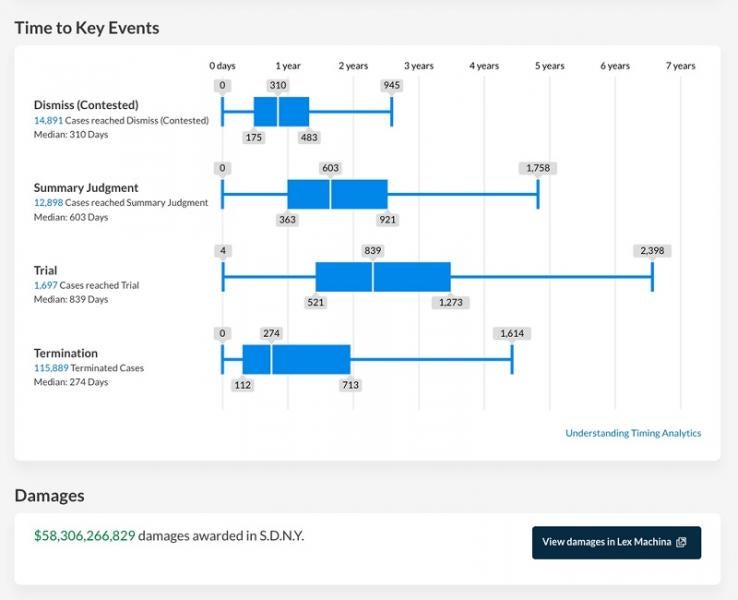
“Many state and local attorneys face a large volume of litigation matters and are looking to add more efficiency into their daily workflow,” says Harmon. “The ability to quickly gain the insight into litigation timelines and anticipated damages is tremendously valuable to advising key administrators and elected officials, and formulating strategies for all the cases that come through the door."
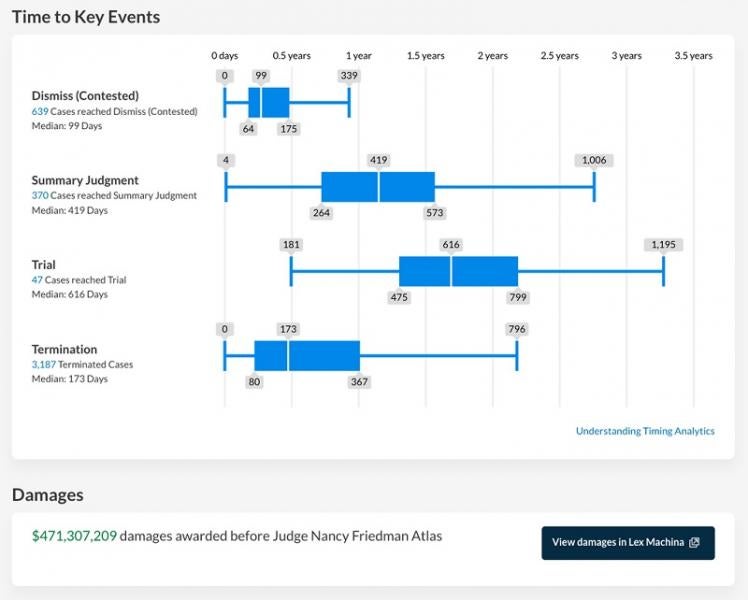
Litigation Analytics is powered by Lex Machina analytics and the Lexis® CourtLink online docket service. As Lex Machina® State Court analytics continues to grow, new content additions are automatically included in Lexis+ subscriptions. Currently, Litigation Analytics has access to some of the larger state jurisdictions in the U.S. including Los Angeles County, Houston and New York. Lex Machina, based in Silicon Valley, is part of LexisNexis.
Litigation Analytics is included at no added cost in the Lexis+ dashboard. Litigation Analytics’ broad stroke insights complement the Legal Research, Practical Guidance and Brief Analysis capabilities. Per Harmon, “Litigation analytics rounds out the overall research workflow—and since it’s an integral part of the Lexis+ search interface with the click of a button, you get everything in one place for the resources to complete tasks, make more informed decisions and reduce the probability of risk in your civil as well as criminal litigation.”
Litigation Analytics in Practice for State and Local Matters – No Longer Rely on Word of Mouth
Litigation Analytics provides overarching data analysis providing big-picture insight into trends and behaviors of regionalized courts and individual judges. This helps attorneys focus on the important factors in a case, preparing them for emerging issues and streamlining preparation so they can learn and prepare based on past behavior. Organized information on the experience of specific judges presiding over your motion and the history of cases previously before the relevant court provides invaluable insight on what to expect and how much detail is needed on certain topics.
The Courts and Judges Comparator in Litigation Analytics also provides data on specific judges’ caseloads, typical duration of cases, and damages awarded. For a government legal department with limited resources at its command, this information on milestones and when to expect judges to rule on a motion is invaluable in stretching resources.
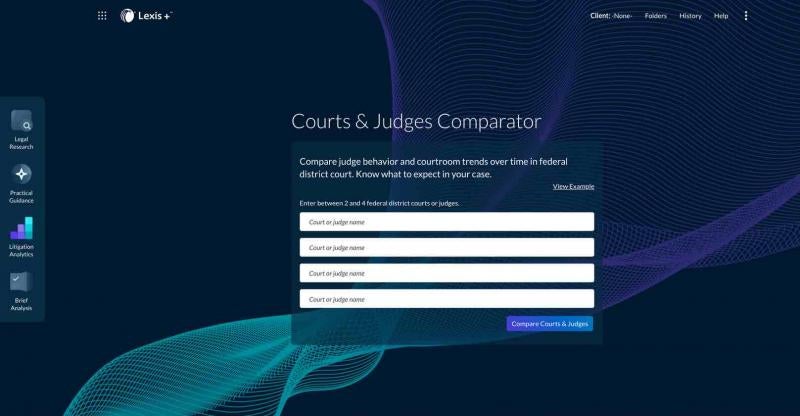
Based on the information provided by Litigation Analytics, attorneys can derive an understanding of the experience level of the judge with the matter before them. Harmon says, “With the insight from judge analytics, you can draft a more compelling argument that will better resonate with your judge, and improve your likelihood of success.”
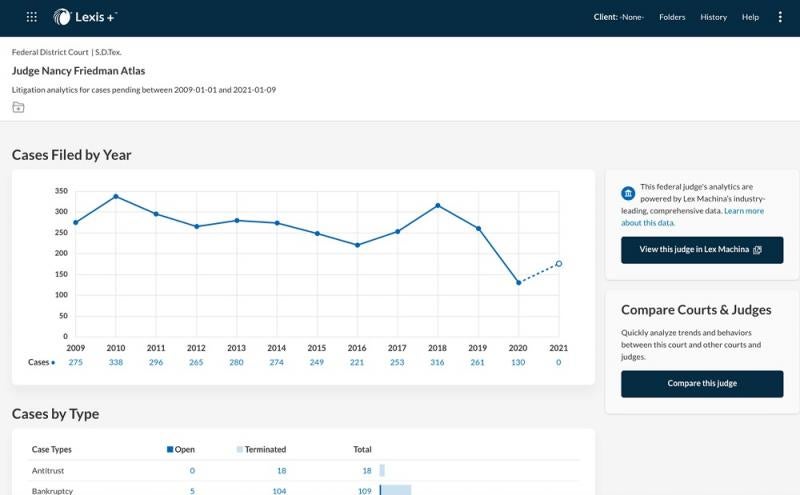
Litigation Analytics also includes a Counsel Comparator, which provides a side-by-side comparison of up to four law firms’ experience data, so you have a strong familiarity of who you’re arguing against by comparing case experience, pending and closed cases, total filings, timing, damages and prominent clients and parties.
User Experience in Lexis+ Litigation Analytics
Based on customers’ input, it was important to create both a streamlined experience and one that was highly intuitive. The design and layout of Litigation Analytics is well thought out and incorporates past usage patterns and feedback from extensive interviews with legal professionals and attorneys. “We use search data visualization to make it a more welcoming experience for new analytics users, to make sure it is a user-friendly interface,” says Harmon.
“Through elegant design that uses relational points to show connections between information, and the use of side-by-side placement to facilitate comparison, we’re providing a modern user experience with a streamlined display requiring virtually no learning curve for the user. This brings unprecedented simplicity to legal search, strategy, insights and guidance.”
Learn more about Lexis+ Litigation Analytics.



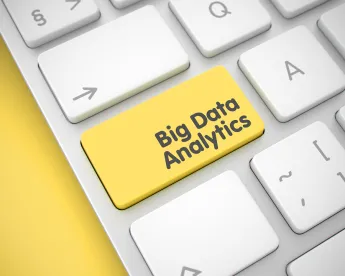
 />i
/>i
